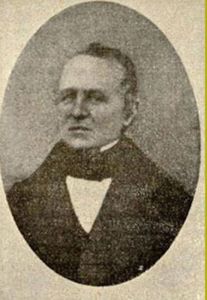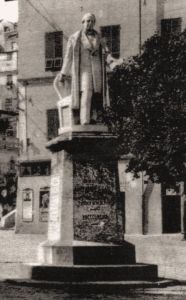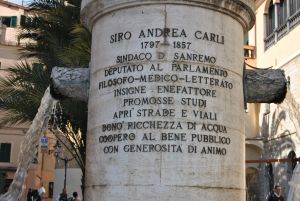Mayor, Doctor, Lecturer and Member of Parliament
 Siro Andrea Carli was born in Sanremo on 7th July 1797 to Stefano and Caterina Allavena, originally from Perinaldo.
Siro Andrea Carli was born in Sanremo on 7th July 1797 to Stefano and Caterina Allavena, originally from Perinaldo.
After completing his early studies in his home town, he graduated with honours in Medicine in Turin on 24 May 1816. He then moved to Pavia, where he worked under the guidance of the famous clinician Siro Borda (1761-1824), then moved on to various Italian cities to work with the most illustrious professors of the time and learn the most advanced medical techniques.
In 1818 he arrived in Rome, but because of his openly liberal ideas, he was forced by the papal government to leave the city and move to Paris, where he completed his studies in chemistry and natural sciences.
In 1820 he moved from the French capital to England, where he sympathised with the liberal British government, visiting Scotland, Portugal, Spain and Gibraltar, before returning to San Remo in December 1821.
In Sanremo he immediately formed a fraternal friendship with the Savoy intendant Alberto Nota, who, in 1827, convinced of the great culture and remarkable abilities of the young doctor from Matutia, proposed him for the post of mayor, but the Piedmontese government, knowing that Carli was a liberal subject, rejected the proposal.
A few months later, however, Nota, not at all discouraged by this refusal, made the request again to the Savoy government, which this time had to yield, and so on 24 February 1828 Carli was officially appointed mayor of Sanremo.
The first problem that the new mayor had to face was that of the water supply of the city, which urgently needed new sources because the inhabitants of Sanremo had been suffering from drought for a long time and were forced to draw water from the puddles of the torrents.
The municipal administration then commissioned the senior aide of the Royal Corps of Civil Engineers Gio Batta Luigi Clerico to find a spring in the surroundings of Sanremo able to supply water to the town, which was eventually identified as the one located on the slopes of the Pian di Castagna mountain, in the locality of Lago Nero. After the construction of the aqueduct and the overcoming of some disputes of state property, on August 15, 1829 the water could finally flow for the first time from the fountains of Piazza dei Dolori, Piazza Capitolo, Piazza di Palazzo (today Piazza Nota) and Piazza Nuova, while in 1834 the obelisk-shaped fountain in Piazza Bresca was inaugurated.
In 1838, as soon as he was re-elected mayor, he decided to move the suburban cemetery from the city centre, near the mouth of the San Romolo stream, to an area located in the Foce district, near the mouth of the San Bernardo stream, in order to purge the city of a source of pestilential miasma.
Five years later he started the construction of an important artery, then called "traversa spaziosa", later called Strada Nuova, then named after King Vittorio Emanuele II, and currently named after Giacomo Matteotti, which would be completed on the eastern side in 1846 by his successor Stefano Roverizio di Roccasterone.
In 1847 he was appointed Reformer of Studies and was also elected for two terms as a deputy to the Subalpine Parliament, where he sat on the left wing benches.
On 24 January 1849 he was elected mayor for the sixth time, remaining in office for a year. He then held the position of councillor in the provincial commissions of Education and Health and auditor in the local charitable institutions.
After giving up political life, he retired to his villa in the western part of the city, where he died on 11 March 1857 from an asthma attack.
His funeral, which succeeded impressively, was attended by all the members of the municipal administration and a large crowd.
(article by Andrea Gandolfo; SanremoNews on the occasion of the 160th anniversary of his death)

 Ten years later, the municipal administration dedicated the Via Traversa (the Fireplace) to him and on 5 January 1890 the statue in his honour was inaugurated in Piazza Eroi Sanremesi, sculpted by the sculptor Filippo Ghersi.
Ten years later, the municipal administration dedicated the Via Traversa (the Fireplace) to him and on 5 January 1890 the statue in his honour was inaugurated in Piazza Eroi Sanremesi, sculpted by the sculptor Filippo Ghersi.
On the pedestal of the monument was inscribed
« Siro Andrea Carli / 1797- 1857 / Mayor of Sanremo / Member of Parliament /
philosopher doctor man of letters / outstanding benefactor / promoted studies /
opened roads and streets. promoted studies / opened streets and avenues /
donated a wealth of water / worked for the public good / with generosity of spirit ».




